1 April 1204 is a significant date in medieval, European history because on that date, at the quiet Abbey of Fontevraud in France, an 82 year old nun took her last breath and died. Her name was Eleanor and she was no ordinary nun. History knows her as Eleanor of Aquitaine. Today, some 819 years later, it feels only right that here on medieval-recipes.com where we celebrate so much of medieval life, we should celebrate the life of this remarkable woman.
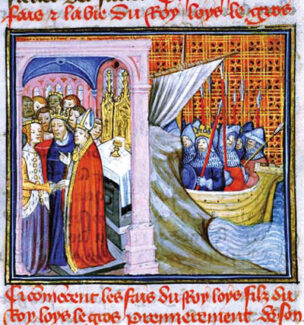
Depiction of Eleanor’s first marriage
Why Was Eleanor Of Aquitaine Special?
Eleanor of Aquitaine was, without doubt, one of the most charismatic, accomplished and powerful women who has ever lived. Her influence on the medieval politics and economic development of Europe (in particular England and France) was unlike that of any other medieval ‘royal’. Indeed, her influence biologically is unlike any other woman of her time because she was the progenitor for almost all the royal houses of Europe.
Eleanor and Her Descendant Queen Elizabeth II
Eleanor had a good education and a keen intelligence. Her strong sense of duty and longevity in her role as a Queen is matched by only one other that I can think of – Queen Elizabeth II of England. Inarguably, these two, remarkable women lived in very different times and took different approaches to resolve the challenges they faced.
Eleanor’s life was not documented in detail and most of the ‘press coverage’ of her era cast her in a less than favourable light. Many historians have since stated they believe this to have been an inaccurate portrayal of Eleanor and the work of politically ambitious (male) clerics, eager to diminish and demonise the strength of character she possessed and the political influence she wielded.
Conversely, Queen Elizabeth II’s life was documented from the day she was born until her death at the age of 96.
What did these two remarkable women have in common?
More than you might imagine! Here are just some of the fascinating things they had in common:
- they shared the same bloodline. Queen Elizabeth II was a descendant of Eleanor and in fact was descended from not just one but both of Eleanor’s marriages!
- as women on a male-dominated political stage, they both held steadfastly to their sense of duty and what they believed was right;
- they were both fluent in more than one language. Eleanor spoke her native Poitevin and Latin. Elizabeth was fluent in English and French;
- they were both avid horsewomen. Below is a photograph of Queen Elizabeth conducting an important but informal meeting on horseback with President Reagan of the United States in 1982. Such was her love of and confidence with being on horseback!

Whilst it is relatively easy to learn of Queen Elizabeth II’s achievements, it is not so much the case with Eleanor. So, in celebration of her life, let’s look at a summary of them.
Eleanor of Aquitaine’s Achievements
- Wife to two Kings (twice a Queen)
She was Queen of France from 1137 to 1152 as the wife of King Louis VII
She was Queen of England from 1154 to 1189 as the wife of King Henry II - Mother of two Kings Of England: King Richard I and King John I
- Mother of 10 children (having possibly had 12 pregnancies according to medieval historian Ralph Turner in his marvellous book Eleanor of Aquitaine)
- Duchess of Aquitaine, ruling in her own right for 67 years from 1137 until her death in 1204.
Note: It was because of Eleanor that Aquitaine became a possession of England and remained in English hands for 299 years (1154-1453). - She went on crusade in 1147 (in her early twenties) to Constantinople and Jerusalem. At the time it was unheard of for aristocratic women to do such a thing but Eleanor convinced her then husband King Louis VII of France to allow her to go with him. The crusade proved to be a disaster for the King but Eleanor received praise and admiration for her display of character and wisdom during the ill-fated trip.
- As Queen consort she often ruled in the stead of two kings, her husband King Henry II of England and her son King Richard I of England (Richard the Lionheart/Coeur de Lion). Both kings spent a lot of time away (crushing rebellion or going on crusade) and they put their trust in Eleanor. Such was her intelligence and capacity for political dealings.
So What Did Eleanor Of Aquitaine Look Like?
After reading about her achievements, you get a sense of what this remarkable woman was like but do we know what she actually looked like? The answer is no, not specifically. There are some medieval depictions such as this one of Eleanor and Henry II which I photographed at Fontevraud Abbey.
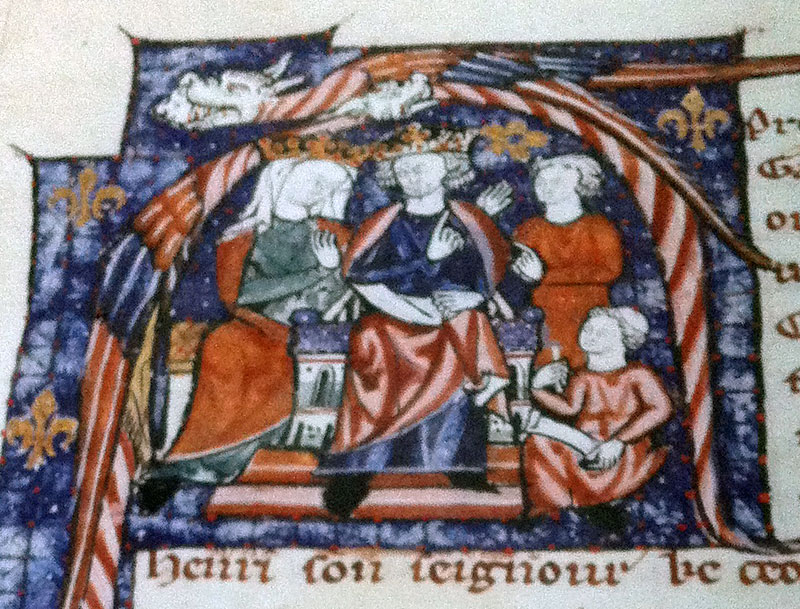
Queen Eleanor and King Henry II
However, no detailed and verifiable account of Eleanor’s physical appearance appears to exist. Her skin, hair and eye colour, for example, are unknown but there are a number of contemporary, written accounts that testify to one thing about her looks – her beauty.
Eleanor’s Beauty
It’s true that many nobles, including noble women, were often praised for their looks by comtemporary writers (often the clergy) who sought to curry favour with the rich and powerful. However, in Eleanor’s case, the sources and actual wording of the testimonies about her beauty all combine to make them feel really genuine.
- As a young woman, one contemporary description uses the Latin word ‘perpulchra‘ which means more than beautiful. So, Eleanor must have made quite an impression – she was not just ‘pulchra’ (Latin for beautiful), she was much more.
- As she entered her thirties, a contemporary of hers and well-known troubadour Bernard de Ventadour used these words to describe Eleanor:
“gracious, lovely, the embodiment of charm”
“lovely eyes and noble countenance”
“one meet to crown the state of any king” - William of Newburgh was another contemporary of Eleanor. He was a 12th century English historian who wrote Chronicles of the reigns of King Stephen, King Henry II and King Richard I. In his writing Newburgh not only mentioned but emphasised Eleanor’s charming personality.
- Even in old age Eleanor appears to have retained her attractiveness. This was attested by another 12th century English chronicler Richard of Devizes who described her as “beautiful“.
- English chronicler Matthew Paris recalled Eleanor’s “admirable beauty” in his 13th century writings.
Imagining The Face Of Eleanor Of Aquitaine
As mentioned above, I have visited the Abbey at Fontevraud and seen Eleanor’s tomb effigy for myself. No-one seems to know who designed it but it is theoretically possible that Eleanor or those who knew her in her later years had a hand in its design. Here are some of my photographs ….
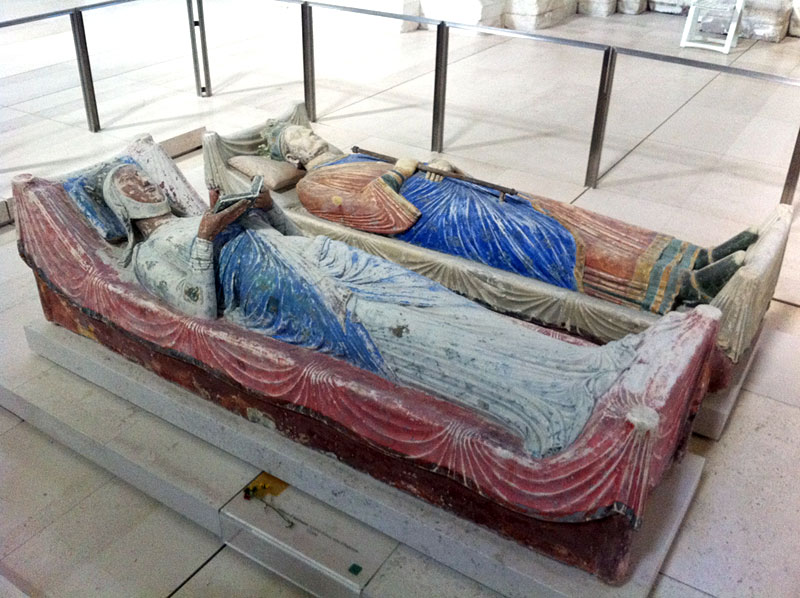
Personally, I am convinced that her tomb is representative of her main features because she is portrayed as being quite tall and long-boned, unusual for the time in which she lived.
Her face is oval shaped with a long, slender nose.
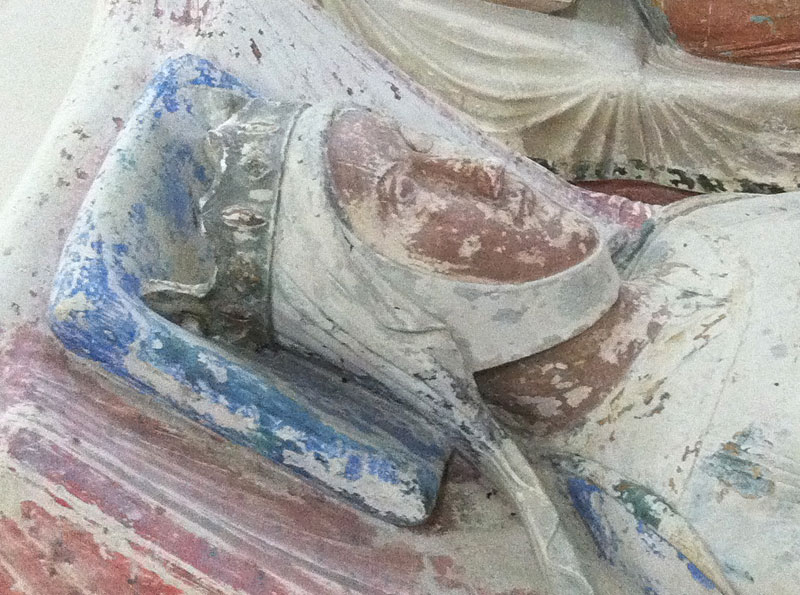
NOTE: I love the fact that Eleanor’s effigy shows her with a book open in her hands – her keen intelligence and zest for life are still there, even in death!
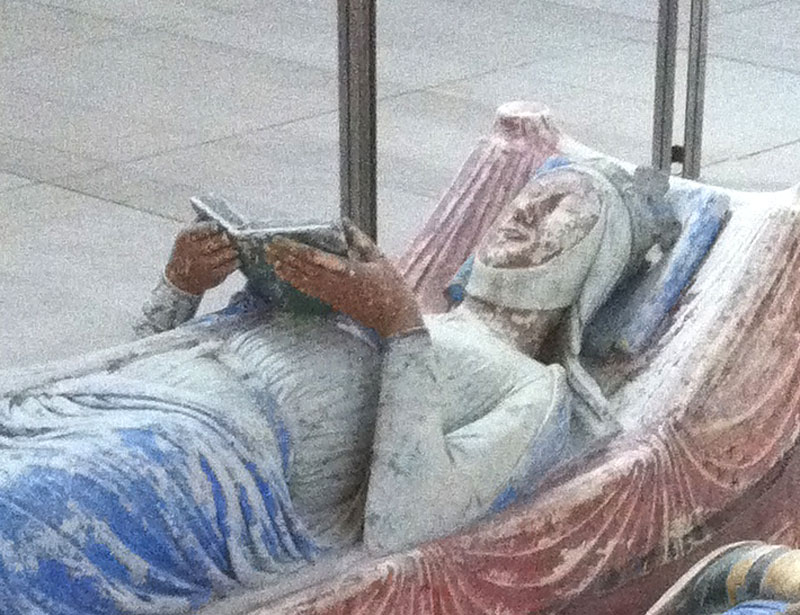
To my mind, if the designer of the effigy did not know Eleanor, they would have chosen more typical features to portray a ‘more than beautiful’ woman. Perhaps a rounder face and more petite stature. This is just my opinion but for a queen’s effigy that lays beside that of her husband, a powerful, medieval king, to portray her as being taller than him achieves no objective, other than to give a realistic impression of how she actually looked.
Eleanor Of Aquitaine’s Face – Images Created With AI
Knowing that we could never find a true depiction of how Eleanor looked, I decided to create my own version. It’s now more readily possible to do such a thing because of AI. So, bearing in mind Eleanor’s unrefuted beauty and charm and that she was quite tall and slender with an oval face, long nose and intelligent eyes, I decided to use an AI bot to create what she might have looked like.
Here are two images I imagined and created …
Eleanor of Aquitaine as a young woman of around 16 years of age, in the early years of her marriage to King Louis VII of France. Seated at the French court (somewhere she is known to have dislliked, hence the rather sombre expression I gave her)

Eleanor Of Aquitaine as a more mature women, around the age of 30 when she married Henry Plantagenet. I imagined her walking in a medieval castle garden, looking thoughtful yet vibrant and confident. Perhaps considering what the future with a new husband and king-to-be might bring.

Whether you agree with me or not on these photographs, one thing is for certain, we should all recognise what a unique woman Eleanor of Aquitaine was.
Honouring Eleanor With A Medieval Ice Cream Recipe
I once read that walnuts were a favourite food of Eleanor of Aquitaine. At the pinnacle of their married years together, her husband King Henry II is said to have sent her a consignment of walnuts as a token of his affection when he was away on campaign.
So, because I have a passion for making homemade ice cream, I conjured up my own medieval ice cream recipe using walnuts and other ingredients available in Eleanor’s time: almond milk, cream, egg yolks, honey. You can use store-bought almond milk of course but I made my own medieval almond milk from scratch which I think gives the ice cream a better texture.
Here is a photo of the very first batch I ever made of my medieval ice cream. Fit for any Queen, but especially Eleanor of Aquitaine!

